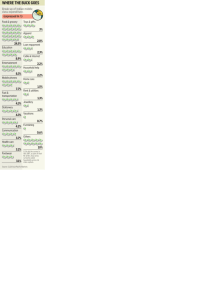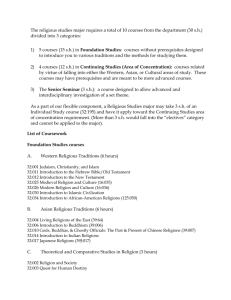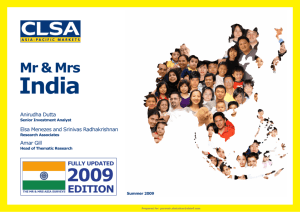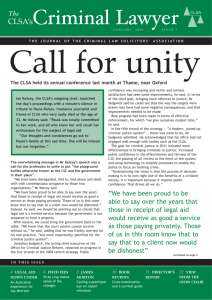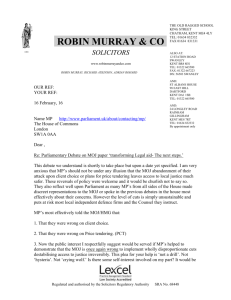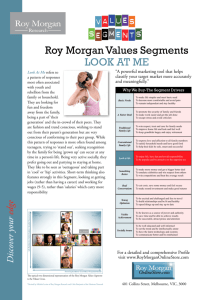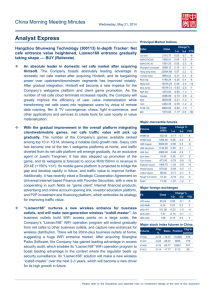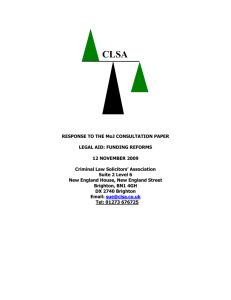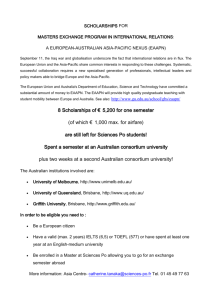3% spend more than US$340/month 43% of the average household
advertisement
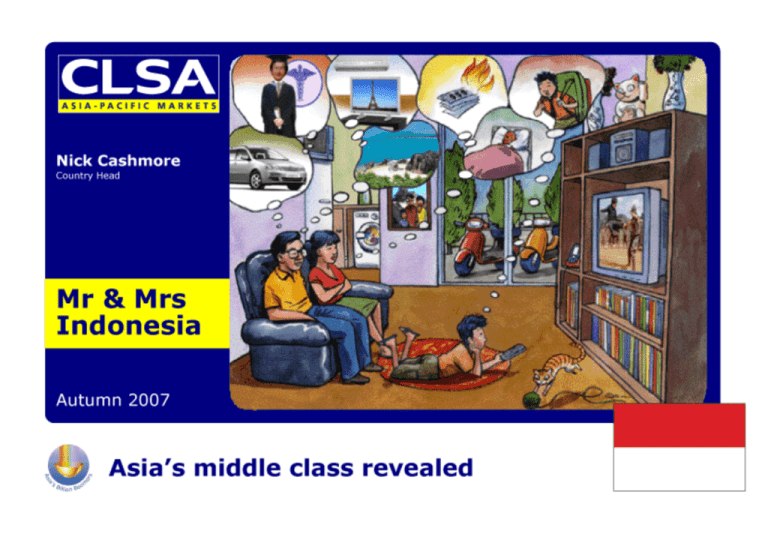
Foreword Eager to tap into the mindset of local households, we approached polling specialist, market-research firm Roy Morgan, to conduct the biggest survey of its kind in Indonesia. Nick Cashmore Country Head Mr & Mrs Indonesia is the outcome of that effort. For two months, Roy Morgan surveyed people in 20 cities across the country - from Medan to Makassar and Banten to Bali. A phenomenal achievement. Of our respondents, 88% were over the age of 18 and the gender split was 50:50 between male and female. In all, we spoke with over 21,000 Indonesians across the country; more than 6,300 people outside of Java alone. The outcome is comprehensive enough to be statistically representative for 67 million urban Indonesians. The results are fascinating: While the country’s middle class may aspire to the sort of lifestyle displayed on the cover of this report, the reality is that most live a much more frugal existence. Only 30% of them have a full-time job and the average income of those that do is not much more than US$1,300 a year. Still, home ownership is high at 80%; although only 5% of our sample live in homes of more than 150 square metres and only 1% have a mortgage, 7% plan to buy a house in the next year. For most of the 60 million households in Indonesia, their home is their biggest asset. Savings are generally sparse. Only 1% own shares; 150 million Indonesians do not even have a bank account. The average savings in the bank of those that do is US$500. Only 4% of households have any form of insurance. Clearly, financial intermediation has a long way to go. Given such financial constraints, the trappings of modern life are still beyond the reach of all but a few. Only a lucky 5% of the households we spoke to have a car and just 1% have a credit card. The basics of life are of a much more pressing concern; over 80% of households do not have access to piped water and more than 33 million households have no sewerage facilities. Mobile telephony is one bright spot and is now a must-have item for many Indonesians, particularly the young. Of the people we spoke to, 30% had a mobile phone and many more intend to obtain one. Motorbikes were a close second. What Indonesians lack in monetary wealth they make up for in family. Seventy percent of households have children and 34% have two or more. Each household has almost four people on average. Education is an important issue for many families; only 3% make it to university and 50% of children leave school with not much more than primary-school education. This report provides a fascinating insight into Indonesian middle-class families. As the fourth most populous country in the world, the combination of a young, more urbanised middle class, aspiring to a modern lifestyle, will be a significant driver of future growth. More evidence of Asia’s Billion Boomers. Our Mr & Mrs Asia series In May 2007, China Reality Research (CRR), our unique research network in China, undertook a comprehensive study of middle-class families across the country culminating in Mr & Mrs China. We then repeated the effort with Mr & Mrs Hong Kong. These first reports in our Mr & Mrs Asia series were well received, addressing the need for granular information that provides a better understanding of the region’s macro data. With Asian consumers set to drive global growth as US consumers pull back, we strive to understand the mindset and aspirations of households across the region, as well as their evolving spending and saving patterns. We asked: Why is the savings ratio so high in most Asian countries? What do families save for? How do they save? What is their appetite for equities? What do they spend on? ©2007 CLSA Asia-Pacific Markets (“CLSA”). IMPORTANT: The content of this report is subject to CLSA's Legal and Regulatory Notices as set out at www.clsa.com/disclaimer.html, a hard copy of which may be obtained on request from CLSA Publications or CLSA Compliance Group, 18/F, One Pacific Place, 88 Queensway, Hong Kong, telephone (852) 2600 8888. Page 2 Key findings Mr & Mrs Indonesia are family-oriented, fiscally challenged Urbanisation is a key growth driver: There are 60m households, growing by 1.5m/year; 33% of homes have six or more people Of those that do, the average savings is <US$500; 1% own stocks and 4% have insurance While 30% of urban households have a motorbike, only 5% have a car and 1% a credit card 85% of people marry before 25; 28% of people <15 years old 33% have a mobile phone; the average user spends <US$10/month 80% own their home; 95% of homes are <150m2; only 1% have a mortgage Over 90% of households have a TV, but only 15% have a DVD player; 85% do not own a digital camera; 90% do not have a microwave oven Only 30% of people have full-time jobs; of those that do, the average income is US$1,300/year Financial penetration is low: Three out of four people do not have a bank account 90% of Indonesians consider religion important in their life ©2007 CLSA Asia-Pacific Markets (“CLSA”). IMPORTANT: The content of this report is subject to CLSA's Legal and Regulatory Notices as set out at www.clsa.com/disclaimer.html, a hard copy of which may be obtained on request from CLSA Publications or CLSA Compliance Group, 18/F, One Pacific Place, 88 Queensway, Hong Kong, telephone (852) 2600 8888. Page 3 Who are they? How old? Roy Morgan interviewed 21,000 Indonesians across the entire archipelago 65+ We focused on interviewing people in the 20 largest cities across the country - from Medan to Makassar 50-64 35-49 25-34 18-24 14-17 (%) 0 5 10 15 20 25 30 Source: Roy Morgan, CLSA Asia-Pacific Markets Where do they live? 88% of respondents were over the age of 18 Greater Jakarta accounted for only 30% of total respondents; almost 4,000 people in Sumatra alone were questioned In all, we spoke with over 6,300 people outside of Java Jakarta region Statistically, this survey is representative of 67m Indonesians and is the largest ever conducted in the country Sumatra West Java East Java Central Java Kalimantan Sulawesi (%) Bali 0 5 10 15 20 25 30 Source: Roy Morgan, CLSA Asia-Pacific Markets ©2007 CLSA Asia-Pacific Markets (“CLSA”). IMPORTANT: The content of this report is subject to CLSA's Legal and Regulatory Notices as set out at www.clsa.com/disclaimer.html, a hard copy of which may be obtained on request from CLSA Publications or CLSA Compliance Group, 18/F, One Pacific Place, 88 Queensway, Hong Kong, telephone (852) 2600 8888. Page 6 Population: Turning towards a city life More people choose to live in cities 100 (% of population) Urban 90 Starting this year, more Indonesians will live in the city than on the farm. England achieved the same percentage around 1820 Rural 80 There are now 110m Indonesians living in cities across the country, a tenfold increase since 1950 70 60 50 40 Each year, that number grows by 3.8m people, almost the population of Singapore. And by 2030, the number of urban Indonesians will double again to 200m 30 20 10 0 1950 1960 1970 1980 1990 2000 2010F 2020F By comparison, over the same period the number of Indonesian farmers will fall by a third Source: Population Division of the United Nations Secretariat Per-capita average income (2003) Indonesia now has eight cities with population of a million people or more; America has nine Professional By 2020, Indonesia will have 12 cities with population over one million people Clerical staff The average urban worker earns almost four times as much (US$4,500/year in Jakarta) as his fellow rural worker (US$1,000/year in Kalimantan) Factory worker Agricultural worker (Rpm) 0 5 10 15 20 25 30 Source: BPS ©2007 CLSA Asia-Pacific Markets (“CLSA”). IMPORTANT: The content of this report is subject to CLSA's Legal and Regulatory Notices as set out at www.clsa.com/disclaimer.html, a hard copy of which may be obtained on request from CLSA Publications or CLSA Compliance Group, 18/F, One Pacific Place, 88 Queensway, Hong Kong, telephone (852) 2600 8888. Page 7 Homes: Poorly served Indonesian families are poorly served by utilities Where do you live? Over 33m households have no access to any sewerage facilities Problems are compounded in Java, which sees the greatest population density The government is encouraging households to shift from kerosene to gas for cooking, so far with limited success The reliance on wood for fuel is higher in rural areas % of population 4.0 58.3 1.5 21.1 7.3 5.7 1.1 Jakarta Java Bali Sumatra Sulawesi Kalimantan Papua Density (1,000 people/km2) 13,100 1,000 600 96 83 22 7 Source: BPS, CLSA Asia-Pacific Markets Type of cooking fuel used Others 1% Electricity 2% Sanitation type by household Toilet with septic tank Wood 12% Gas 17% 44 Toilet without septic tank 14 River 14 Directly into septic tank 8 Shared toilet 8 Bushes Kerosene 68% 4 Public toilet 3 Others 3 0 Source: BPS, CLSA Asia-Pacific Markets (%) 10 20 Source: BPS, CLSA Asia-Pacific Markets ©2007 CLSA Asia-Pacific Markets (“CLSA”). IMPORTANT: The content of this report is subject to CLSA's Legal and Regulatory Notices as set out at www.clsa.com/disclaimer.html, a hard copy of which may be obtained on request from CLSA Publications or CLSA Compliance Group, 18/F, One Pacific Place, 88 Queensway, Hong Kong, telephone (852) 2600 8888. Page 11 30 40 50 Consumption: Limited options Breakdown of spending Transport, communication 14% Education, sports, recreation 6% The average family in our sample spends Rp1.1m (US$118) a month Food 25% Health 4% 85% of households spend less than US$185/month; 3% spend more than US$340/month Processed food, beverages, tobacco 18% Clothing 6% 43% of the average household budget are spent on food, beverages and cigarettes Housing 27% Source: BPS Indonesians on average smoke 1,000 sticks of cigarettes each year per person Average monthly household expenditure (Rp000) 4.25m+ 3.25-4.25m Including housing, 70% of spending goes on basic consumer items 2.25-3.25m 1.75-2.25m 1.25-1.75m 800-1.25m Only 6% of household spending go on education, sport and holidays 600-800 400-600 <400 (No. of respondents) No answer 0 1,000 2,000 3,000 4,000 5,000 6,000 Source: Roy Morgan ©2007 CLSA Asia-Pacific Markets (“CLSA”). IMPORTANT: The content of this report is subject to CLSA's Legal and Regulatory Notices as set out at www.clsa.com/disclaimer.html, a hard copy of which may be obtained on request from CLSA Publications or CLSA Compliance Group, 18/F, One Pacific Place, 88 Queensway, Hong Kong, telephone (852) 2600 8888. Page 14 Savings: Sparse Only 1% hold stocks; 95% do not have a pension plan The low penetration of Jamsostek, the stateowned workers’ insurnace company, reflects low workforce participation in the formal economy Do you have a pension plan? Company managed 1% Jamsostek 3% Other 1% None 95% 56% of people have less than US$500 savings in the bank Nationwide, 1.7% of accounts control 77% of total deposit Amount of money in the bank Rp50m+ 20% <Rp1.0m 19% Source: Roy Morgan, CLSA Asia-Pacific Markets Do you hold any stocks? Yes 1% Rp10-50m 10% Rp5-10m 14% Rp1-5m 37% Source: Roy Morgan, CLSA Asia-Pacific Markets No 99% Source: Roy Morgan, CLSA Asia-Pacific Markets ©2007 CLSA Asia-Pacific Markets (“CLSA”). IMPORTANT: The content of this report is subject to CLSA's Legal and Regulatory Notices as set out at www.clsa.com/disclaimer.html, a hard copy of which may be obtained on request from CLSA Publications or CLSA Compliance Group, 18/F, One Pacific Place, 88 Queensway, Hong Kong, telephone (852) 2600 8888. Page 16
